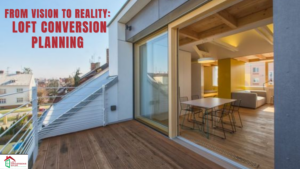Are you looking to convert your small attic to gain additional space in your home? A loft conversion is always an attractive and practical way to add value to your home by up to 20%, but the challenge is how would you convert it into a multi-use and beautiful space.
Our lofts often become spaces that get filled with clutter and junk and never see the light of day. If you’re looking to transform your home and make the most of your space, a loft conversion is a great way to clear your clutter and add a beautiful extra bedroom, bathroom, office or playroom to your space.
In this article, we’ll share with you a series of small loft conversion ideas that will guide you in creating and transforming the small space in your loft, to multiple different opportunities, from a new small bedroom, extra family bathroom and wash area, to a storage area with sloping eaves, it’s always helpful to have the extra space.
What loft conversion types are suitable for small loft spaces?
Roof Light/ Velux Loft Conversions
Installing a Velux window to transform your attic into a liveable space is one of the most low-cost loft conversion options for small houses that doesn’t require any external alteration to your roofline. It will work well if the attic has enough headroom. For a comfortable and liveable Velux loft conversion your loft must have 2.2m headroom at the most central point.
If you’re unsure of the height and headspace in your loft why not get in touch with a local loft conversion specialist so they can come and survey your space and talk you through your best options for a small loft conversion.
If you’re loft space isn’t suitable for a Velux window installation, adding roof lights can introduce natural lights to your space, making it more spacious and airy.
You can incorporate new technologies in your loft, such as a thermostat that automatically opens or closes Velux windows when your room reaches the pre-selected temperature. Or you can fit rain sensors so that it will close on its own when it detects rain. These would be of good help if your ceilings are high, and reaching the windows is difficult for you.
Of course, if you’re not planning on using your loft as a regular room and rather storage, there are cheaper options, in which you won’t have to spend added expenses on larger windows.
Dormer Loft Conversions
If you want to gain additional space and headroom out with a small loft conversion, then a dormer loft conversion would suit you. A dormer conversion basically adds an extension to your attic’s square footage and is often placed at the rear part of your roof.
A dormer loft conversion is ideal for adding an additional bedroom, study room, home office, or nursery. They’re a great way to maximise a small space and turn it into a stunning feature.
For small loft conversion ideas you can also transform your loft space into an ensuite or use it as a walk-in closet or separate dressing room.
If you’re looking for a little extra closet space or for a quiet space to relax, a single dormer would do the job for your loft conversion. But if you want to maximise the space you have and achieve a completely different feel to your home, then a full-width dormer may be the right choice for your small attic conversion.
Mansard Loft Conversions
If you need a full-scale extension to give you maximum space, this option may be the best for you. It usually requires planning permission and a bigger budget since you’ll have to do a significant alteration to the roofline of your attic. But the wider liveable area, light and impeccable design a mansard attic conversion can give makes it worth the investment.
The Mansard loft conversion is the ideal solution for a spare bedroom or extra living space. The full-scale extension means you have a spacious living area rather than just a converted space.
A flat roof usually characterises a mansard loft conversion with a sloping back wall at 72 degrees. You can also upgrade your loft conversion by adding more features like a Juliet Balcony to enhance the aesthetics further and maximise the natural light that enters the loft. Incorporating a Mansard loft conversion into your home typically involves installing a staircase. The staircase can be designed beautifully to match your new lofts aesthetic, and the aesthetic of your home, so you have a seamless design.
The Mansard loft conversion is more on the spacious loft conversion scale as opposed to a small loft conversion. However, the Mansard conversion is a great investment, particularly if you’re a growing family or looking to a set up a working from home base.
Hip-to-gable Loft Conversions
Most houses with hipped roofs like those in a semi-detached home have small internal volume. So if your property has a semi-detached design, this conversion type which involves changing the sloping roof to a vertical gable structure, is a practical solution to gain more space in your loft.
These are a great solution if you’re looking to add new room to your home rather than simply maximising the space you already have. The hip-to-gable loft conversion is another great solution for growing family homes or those looking to increase the value of their home. This loft conversion will give you additional headroom as well as additional storage and living space for you and your family.
With this type of loft conversion you can go extravagant or practical. Transform your new space into a quiet and secluded bedroom, maybe even an office space or playroom. Or why not design a cosy and luxurious cinema room where you can relax with friends and loved ones and enjoy the latest blockbusters and all time favourite cinematic moments.
Terraced House Loft Ideas
No matter what your loft conversion plan may be, it’s always good to have an idea of what you want your new space to incorporate.
Storage Ideas
Using your loft as a storage space for all your stuff might be the answer to your storage problems, and the good news is it isn’t an expensive option. However, you need to bear in mind that not all lofts can carry heavy loads of bulky objects. So, you need to ensure that your newly converted attic space is safe to use.
Cosy den
If you want a space dedicated to your hobbies, like playing video games or watching a movie, then you can make use of your loft to relax and unwind or pursue your passion. With some bean bags, cupboards, textured flooring, lighting and a few personal touches, you can easily transform your loft into a relaxing space in your home.
Play Area
Turning your loft into a playroom for your little ones is also a good way to make use of your attic space. The slanted walls look similar to a big tent, giving them a camping aesthetic. With creativity and a little enhancement using interesting wallpapers and chalkboards, you can bring a sweep of magic into a new play area.
Since kids want a space to adventure and play, you don’t need to fill the loft with furniture. Simply keep your walls a neutral and bright colour and add a table with comfy stools, accessible toy storage, bean bags, bookcases and soft rugs for the complete playroom look.
By keeping the walls and colour scheme neutral your space can easily evolve and grow up with your kids. Over the years your small loft conversion can transform into a gaming room, dressing room, movie room or even a sleepover room.
Spare Bedroom
If you need an extra bedroom for your family members, friends or visitors, a loft conversion bedroom is a great idea.
First things first, if you’re thinking of transforming your loft or attic space into a spare bedroom you need to ensure that your attic has enough headroom to make it a comfortable space. If your ceiling is too low, you can either alter the roofline and install dormers or mansards or lower the ceiling to the room below. In this case you will need to consult with professionals regarding your plans to ensure that the project and alterations comply with the building regulations.
When it comes to styling your bedroom, you can either incorporate a timeless and classic design to give guests a memorable stay opt for a clean and contemporary aesthetic that’s comfortable and inviting for all guests. Since your loft will be a blank canvas, you have a wide range of styling options for the interiors to make it your ultimate comfort space.
Cinema Room
If you have no plans to make your loft a cosy bedroom, how about an epic home cinema? You may need to do some soundproofing, though, to avoid causing hassle to your neighbours. It would be best to use a dark colour scheme similar to a real cinema, but it doesn’t always have to be black. You can go for the dark blue, mossy green, or crimson for a classical cinema feel. Add some blinds or a black curtain, and your cinema room is good to go.
Home Office or Study Room
A home office or study area requires less space and is a lot easier and cheaper than converting a loft into a bedroom. Therefore, it’s a practical option for a smaller budget and smaller loft space. Natural light is crucial for an effective working space, it makes you feel productive and is a key way to staying fresh and motivated throughout the day. Velux windows or dormers are a great option here, they let in more natural light and can also make the area look more spacious, as well as being less harsh than conventional office building lights.
Semi-Detached House Loft Conversion Ideas
Extra bathroom or ensuite
An extra bathroom should could go hand in hand with an additional bedroom in your loft. To maximise the space well, we recommend placing bathtubs or storage drawers under the eaves using low-level storage and installing shower stalls or wet rooms where the head height is generous enough.
Home office
Since more and more people today are working from home, having a room dedicated to work or studies is becoming a necessity, and a loft is an ideal place for a home office. With a office loft conversion you can truly make the space your own with a range of different features:
- Floor to ceiling windows for a hit if nature and natural light
- Juliet balcony for a stunning architectural feature and fresh air flow
- Built in storage for all your work accessories
- Sound-proofing so you can get on with your work and study without any distractions from the rest of the house
Extra living room
Living space in a loft conversion where you can overlook the cityscape or eye-pleasing landscape is ideal for relaxation. Install warm lighting and comfortable lounge seating and you’ve got yourself a little oasis away from the hustle and bustle of the rest of your home. Turning your small loft conversion into and extra living space is also a great opportunity to highlight the original features of your property. If your home has wooden beams running through the attic space, using white paint and wooden furniture is a great way to incorporate your homes original features into your new aesthetic.
Walk-in closet
If you’re looking for a space where you can store your clothes and accessories, then look no further than your attic. With a small loft conversion, you can make use of the quirky angles to create a beautiful and organised walk-in wardrobe. However, proper ventilation is vital to prevent mould and keep your items fresh. Complete your new space and accessorise with a statement floor to ceiling mirror and dressing table with all your accessories.
Cost of Small Conversions
Basic or tiny loft conversions are relatively cheaper, costing between £15,000 to £17,000. However, a larger conversion consisting of a middle-sized room with a double bedroom and two windows will cost around £18,000-£25,000. If you have the square footage an attic space with two large bedrooms and ensuite can cost you anywhere between £25,000 to £40,000 depending on the features you decide to include as part of your conversion.
If we would take the loft conversion types into account, these numbers can easily fluctuate depending on the kind of work you’re planning to do. The cheapest and least disruptive conversion is the Velux loft conversion, costing around £15,000-£20,000.
On the other hand, for a dormer loft conversion that can significantly increase the amount of headspace in your attic, you can expect to pay £30,000 to £60,000.
A hip-to-gable loft conversion which works well with detached and semi-detached homes can provide a lot of extra space, but since it requires roof alteration, it can be more expensive, ranging from £40,000 to £65,000.
The most expensive option is the Mansard attic conversion because it will incorporate changing your roof’s whole shape, making it look flat or almost vertical from the outside. It can cost anywhere between £45,000-£70,000.
Loft Conversion Insulation
Regardless of the type of loft conversion or how large the area is, insulating is essential for every project in your home. Since attic conversion became more popular in the UK, the regulations have also became more stringent. Even modifications done a decade ago are not likely to meet the standard these days if it has very little insulation.
Building regulations state that your roof’s u-value (thermal transmittance) must be 0.18W/m2 or less, which means that the insulation layer should be 270mm thick with a 175mm rigid board or a spray foam filling of about 125mm thick. If your existing loft insulation doesn’t meet these standards, then you may need to retrofit new insulation when you convert your attic. It can help reduce the amount of heat loss in your roof. Hence the amount of fuel needed to burn for heating will be reduced, and you will have lower energy bills and a better energy-efficiency rating for your home.
If you need a step-by-step guide in DIY loft insulation, you may find this article helpful in getting the job done yourself.
But aside from loft insulation, there are many more regulations that you must adhere to when converting your attic space.
Loft Conversion Building Regulations
Building regulations created by the government set standard building works a loft conversion to ensure that every work is structurally sound. The elements that will be assessed if it meets the building regulation approval are the following:
Fire safety: Installing fire-resistant doors is crucial to ensure that the new room is safe from fire, and mains-powered alarms are also necessary to send a signal in case of fire.
Floor and beams: Adding new floor joists is also necessary to support the room’s weight and everything in it.
Sound insulation: The loft will also be assessed to make sure it is sufficiently-insulated.
Stairs: Staircases or stairs often provide an escape in case of fire, and retractable staircases or ladders are usually not acceptable.
Walls: The external and internal walls need to be checked to ensure that they can carry the load and structural stability. It must also be examined for thermal efficiency and weather resistance, and it was re-rendered or cladded well. The new walls must also support the existing or new roofs if the previous supports have been removed.
Doors and windows: You’ll also need to ensure that your windows and doors are energy-efficient to prevent thermal heat loss.
Roof: Inspecting it is also crucial to see if there’s a movement in the alteration that can cause cracks in the walls. It must also be checked to ensure that it would not collapse and it has proper support.
Electrics: The electrics in your loft must also comply with the building regulations. So, you may need to pick a qualified or registered professional to do the notifiable works such as the fuse box or consumer unit installation and fitting of a new circuit or alteration to an existing one.
Drainage: You’ll also need to increase your rainwater pipes and gutters if the roof size was increased because insufficient drainage can put you at risk of flooding.
Height: The minimum headroom height for a traditional roof is usually 2.2 to 2.4 meters, while for a modern trussed roof, it has to be around 2.4 to 2.6 meter high.
Kitchen and bathrooms: Inspectors don’t necessarily need to check your kitchen and bathroom, but the ventilation, thermal performance, drainage and fire safety in it must pass the requirements stated in the building regulation.
Other Things To Consider Before The Loft Conversion
Party Wall Agreement
This agreement is necessary if the work will affect the wall that joins your house to your neighbour to ensure that it will be fair and won’t put your neighbour’s property in danger. So, you need to give a Party Wall Notice that will summarise the proposed work and provide copies of your plans to your neighbours before the work could commence. If they have some concerns, they may ask an independent party wall surveyor to inspect the projects, ask for reasonable amendments if needed and approve the work.
Protected Species
If bats live on your roof, you need to have a bat survey because they are a protected species, and you may need to get a mitigation license to carry out the work if you found out that your loft shelters them. The survey can cost you around £300 to £400 or more.
Complying with building regulations is undoubtedly tricky and time-consuming, but they are made to protect you and give you peace of mind knowing that your loft meets the standard. If you want to avoid issues and delay in the project, you’ll need to hire a competent builder or professionals that truly understand these building regulations and provide quality output and excellent quality.


